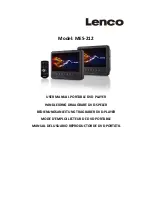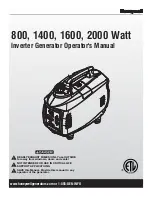
aXis CONTROLLER HOME STANDBY GENERATOR
INSTALLATION
20
SUGGESTED PREPARATION
A concrete pad can be poured or purchased through Champion
(model 100616) and the HSB secured to it. In some areas a
concrete pad is required due to high wind potential. Check
local codes to see what type of mounting base is required. If a
concrete pad is required, all federal, state and local codes should
be followed. Unless mandated by federal, state or local code, a
concrete pad is not required.
If no concrete pad is being used, Champion recommends using a
mixture of pea gravel and sand or crushed stone for placement of
the mounting pad. The mounting pad MUST be level. The gravel
mixture or crushed stone is to permit water runoff, drainage and
reduce ponding of water around the HSB.
Dig an area 5 inches (12.7 cm) deep that is 6 inches (15.2 cm)
longer and wider than the foot print of the HSB. The HSB is 49
inches long × 28 inches wide (124.5 cm long × 71 cm wide).
Cover the dugout area with a weed barrier or landscape cloth if
desired.
Fill the area with pea gravel and sand mixture or crushed stone.
Final stone level must be 2 or 3 inches higher than the original
ground level to ensure water run-off and drainage.
Compact the fill, this is to provide a firm base for the HSB.
Remember the final stone level must be 2 or 3 inches higher than
the original ground level to ensure water run-off and drainage.
Tools required
1. General SAE and Metric hand tools, wrenches, sockets and
screwdrivers.
2. Standard electrician’s hand tools, drill and bits.
3. Monometer (for checking fuel pressures).
4. Meter capable of measuring AC/DC Voltage and Frequency
5. Safety apparel
Inspect the unit. Carefully inspect the HSB for any damage
that may have occurred during shipment and delivery. If loss
or damage is noted at the time of delivery, have the person(s)
making delivery note all damage on the freight bill and affix their
signature under the consignor’s memo of loss or damage. If loss
or damage is noted after delivery, separate the damaged materials
and contact the carrier for claims procedures. Parts damaged in
shipping are not covered under Champion warranty.
Unbox the unit, by removing the exterior shipping carton. The ATS
is included, remove the packaging and lift it out. Remove the 4
shipping brackets, 2 on each end that hold the HSB to the wood
shipping pallet. This pallet is for shipping/transportation only and
cannot be used as a mounting pad in any form. Exercise caution
when removing the HSB from the wood pallet, dragging it off the
wood pallet will damage the HSB base. The HSB must be lifted
from the wood pallet to separate.
Contact your natural gas (NG) supplier about the meter size. Most
meters must be replaced with a larger BTU size, due to a larger
demand of BTU’s from the HSB and appliances during operation
(utility outage). This also applies to HSB utilizing LPG.
SUGGESTED PLACEMENT
The Site Selection has been completed, all federal, state and local
codes have been reviewed and applied as mandated by the NFPA
standards and all other related codes/standards.
Preparation has been completed and everything has been properly
prepared to place the HSB.
The rear right side of the HSB locates the fuel and wire entry
points. When placement is done this side generally faces the
closest point to each of those sources for fuel and wire entry.
WARNING
HSBs weigh approximately 300-500 lbs (136-227 kg)
depending on the model. Proper tools, equipment and qualified
personnel should be used in all phases of handling and moving
the HSB. Do not lift or move the HSB without assistance. Do
not lift the unit by the roof structure or any other enclosure
component as damage to the HSB may occur, including
possible injury of persons when handling and or moving the
HSB in this manner.
Two (2) 5 foot (1.5 m) lengths of ¾ “steel pipe (supplied by the
installer), are required to lift the HSB. Insert the steel pipes
through the lifting holes located near the HSB base in the
composite pad, on each end.
















































